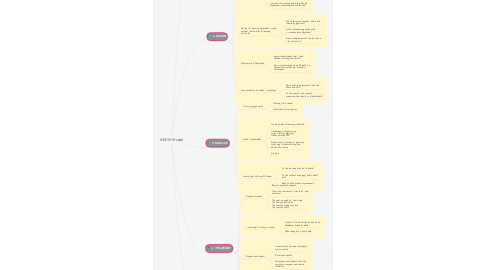
1. 1. ANALYSIS
1.1. Clarify problems
1.1.1. What is the training need? Why is the course being developed?
1.1.2. What are the potential barriers?
1.1.3. How will ideas be communicated to clients, design teams, SME and stakeholders?
1.1.4. What are the physical and organisational constraints?
1.2. Clarify goals and objectives
1.2.1. What skills and knowledge will the participants gain after the training?
1.2.2. How will training impact the organisation? How will this be measured?
1.2.3. What are the learning outcomes or success criteria?
1.2.4. What are the main goals of the organisation?
1.2.5. How will the organisation acknowledge the achievements of participants? e.g. accredited course, certification, unit of competency.
1.3. Clarify logistics
1.3.1. How will training be delivered?
1.3.2. Where will training take place?
1.3.3. What is the cost of resourcing (content, technology, people and facilities)?
1.3.4. Who is involved in developing the resources?
1.4. Identify audience
1.4.1. Who are the learners?
1.4.2. What do they know already?
1.4.3. Who are my clients, team and stakeholders?
1.4.4. What skills and experiences do they have?
2. 2. DESIGN
2.1. Structure of course
2.1.1. Is the structure logical to learners?
2.1.2. Does the design structure of the LMS supports the content?
2.1.3. Is the time frame adequate for course completion?
2.1.4. How will the content and activities be sequenced, presented and reinforced?
2.2. Outline of learning objectives, course content, lesson plan & learning activities
2.2.1. Does the course content match the learning objectives?
2.2.2. What methodology will be used to achieve each objective?
2.2.3. What media/resources will be used in the instruction?
2.3. Assessment & Feedback
2.3.1. How will participants get their feedback during the course?
2.3.2. How will participants be assessed? e.g. formative, summative, authentic assessment...
2.4. Communication of ideas - prototype
2.4.1. What will the end product look like (show and tell)?
2.4.2. Is the process and product communicated clearly to stakeholders?
3. 3. DEVELOP
3.1. Training programmes
3.1.1. Training for trainers
3.1.2. Certficate of completion
3.2. Create deliverables
3.2.1. Course guides & training materials
3.2.2. Technology integration e.g. Online training scenarios, videos, quizzes, APPS
3.2.3. Assessments, tracking & reporting strategy - before, during and after the course.
3.2.4. Graphics
3.3. Course pilot testing & Review
3.3.1. Is the learning solution suitable?
3.3.2. Is the content engaging? What works well?
3.3.3. What needs further improvement?
4. 4. IMPLEMENT
4.1. Prepare trainers
4.1.1. Recruit qualified trainers
4.1.2. Train the trainers on the use of new resources
4.1.3. The goal or goals of the course. The course’s activities. The course’s media content. The course’s tests.
4.2. Course pilot testing & review
4.2.1. Conduct a small simulation and take feedback; evaluate data
4.2.2. Make changes to the course
4.3. Prepare participants
4.3.1. Communicate welcome message & course outline
4.3.2. Enrol participants
4.3.3. Familiarise participants with the computer program and course schedules.
4.4. Prepare learning space
4.5. Begin training
4.5.1. Face to face session (workshop)
4.5.2. Online training programme
4.5.3. Delivery, tracking & reporting handled by LMS
5. 5. EVALUATE
5.1. Formative evaluation
5.1.1. Is the quality of learning resources fit for purpose? (done during development phase)
5.2. Summative evaluation
5.2.1. Participant satisfaction survey
5.2.2. Skills and knowledge gained
5.2.3. Impact on performance
5.2.4. Identify other training requirements

